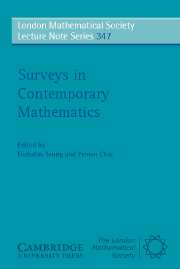Book contents
- Frontmatter
- Contents
- Preface
- Rank and determinant functions for matrices over semirings
- Algebraic geometry over Lie algebras
- Destabilization of closed braids
- n-dimensional local fields and adeles on n-dimensional schemes
- Cohomology of face rings, and torus actions
- Three lectures on the Borsuk partition problem
- Embedding and knotting of manifolds in Euclidean spaces
- On Maxwellian and Boltzmann distributions
Rank and determinant functions for matrices over semirings
Published online by Cambridge University Press: 16 March 2010
- Frontmatter
- Contents
- Preface
- Rank and determinant functions for matrices over semirings
- Algebraic geometry over Lie algebras
- Destabilization of closed braids
- n-dimensional local fields and adeles on n-dimensional schemes
- Cohomology of face rings, and torus actions
- Three lectures on the Borsuk partition problem
- Embedding and knotting of manifolds in Euclidean spaces
- On Maxwellian and Boltzmann distributions
Summary
Introduction
The difference between semirings and rings is the lack of additive inverses in semirings. The most common examples of semirings which are not rings are the non-negative integers ℤ+, the non-negative rationals ℚ+ and the non-negative reals ℝ+ with usual addition and multiplication. There are classical examples of non-numerical semirings as well. One of the first examples appeared in the work of Dedekind in connection with the algebra of ideals of a commutative ring (one can add and multiply ideals but it is not possible to subtract them). Later Vandiver proposed the class of semirings as the best class of algebraic structures which includes both rings and bounded distributive lattices. Boolean algebras, max-algebras, tropical semirings and fuzzy scalars are other important examples of semirings. See the monographs for more details.
During the last few decades, matrices with entries from various semirings have attracted the attention of many researchers working both in theoretical and applied mathematics. It should be emphasized that the majority of examples of semirings arise in various applications of algebra. To illustrate an application of semirings, we present a situation that arises constantly in parallel computations. To make this situation more apparent, we give its ‘real life’ analogue. Let us consider k seaports. A ship with certain goods arrives at the i-th port at the moment xi, i = 1, …, k. Also there are l airports with a airplane in each airport.
- Type
- Chapter
- Information
- Surveys in Contemporary Mathematics , pp. 1 - 33Publisher: Cambridge University PressPrint publication year: 2007
- 1
- Cited by



